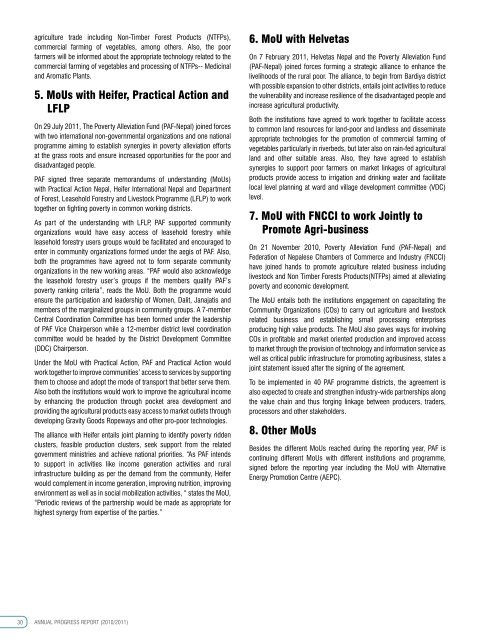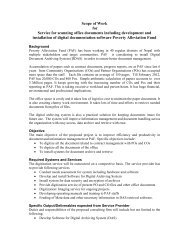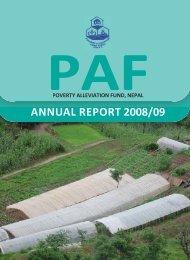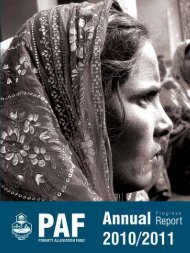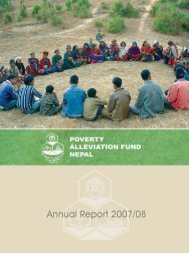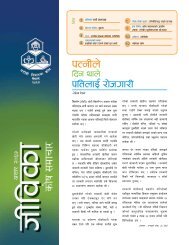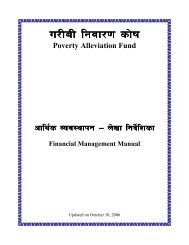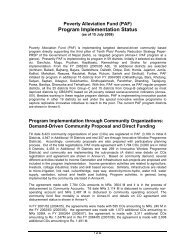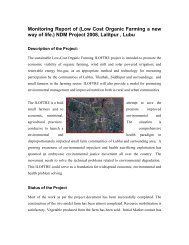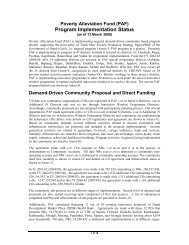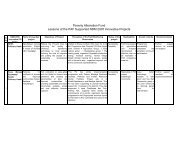Fiscal year 2010/11 - Poverty Alleviation Fund, Nepal
Fiscal year 2010/11 - Poverty Alleviation Fund, Nepal
Fiscal year 2010/11 - Poverty Alleviation Fund, Nepal
Create successful ePaper yourself
Turn your PDF publications into a flip-book with our unique Google optimized e-Paper software.
agriculture trade including Non-Timber Forest Products (NTFPs),<br />
commercial farming of vegetables, among others. Also, the poor<br />
farmers will be informed about the appropriate technology related to the<br />
commercial farming of vegetables and processing of NTFPs-- Medicinal<br />
and Aromatic Plants.<br />
5. MoUs with Heifer, Practical Action and<br />
LFLP<br />
On 29 July 20<strong>11</strong>, The <strong>Poverty</strong> <strong>Alleviation</strong> <strong>Fund</strong> (PAF-<strong>Nepal</strong>) joined forces<br />
with two international non-governmental organizations and one national<br />
programme aiming to establish synergies in poverty alleviation efforts<br />
at the grass roots and ensure increased opportunities for the poor and<br />
disadvantaged people.<br />
PAF signed three separate memorandums of understanding (MoUs)<br />
with Practical Action <strong>Nepal</strong>, Heifer International <strong>Nepal</strong> and Department<br />
of Forest, Leasehold Forestry and Livestock Programme (LFLP) to work<br />
together on fighting poverty in common working districts.<br />
As part of the understanding with LFLP, PAF supported community<br />
organizations would have easy access of leasehold forestry while<br />
leasehold forestry users groups would be facilitated and encouraged to<br />
enter in community organizations formed under the aegis of PAF. Also,<br />
both the programmes have agreed not to form separate community<br />
organizations in the new working areas. “PAF would also acknowledge<br />
the leasehold forestry user’s groups if the members qualify PAF’s<br />
poverty ranking criteria”, reads the MoU. Both the programme would<br />
ensure the participation and leadership of Women, Dalit, Janajatis and<br />
members of the marginalized groups in community groups. A 7-member<br />
Central Coordination Committee has been formed under the leadership<br />
of PAF Vice Chairperson while a 12-member district level coordination<br />
committee would be headed by the District Development Committee<br />
(DDC) Chairperson.<br />
Under the MoU with Practical Action, PAF and Practical Action would<br />
work together to improve communities’ access to services by supporting<br />
them to choose and adopt the mode of transport that better serve them.<br />
Also both the institutions would work to improve the agricultural income<br />
by enhancing the production through pocket area development and<br />
providing the agricultural products easy access to market outlets through<br />
developing Gravity Goods Ropeways and other pro-poor technologies.<br />
The alliance with Heifer entails joint planning to identify poverty ridden<br />
clusters, feasible production clusters, seek support from the related<br />
government ministries and achieve national priorities. “As PAF intends<br />
to support in activities like income generation activities and rural<br />
infrastructure building as per the demand from the community, Heifer<br />
would complement in income generation, improving nutrition, improving<br />
environment as well as in social mobilization activities, “ states the MoU,<br />
“Periodic reviews of the partnership would be made as appropriate for<br />
highest synergy from expertise of the parties.”<br />
6. MoU with Helvetas<br />
On 7 February 20<strong>11</strong>, Helvetas <strong>Nepal</strong> and the <strong>Poverty</strong> <strong>Alleviation</strong> <strong>Fund</strong><br />
(PAF-<strong>Nepal</strong>) joined forces forming a strategic alliance to enhance the<br />
livelihoods of the rural poor. The alliance, to begin from Bardiya district<br />
with possible expansion to other districts, entails joint activities to reduce<br />
the vulnerability and increase resilience of the disadvantaged people and<br />
increase agricultural productivity.<br />
Both the institutions have agreed to work together to facilitate access<br />
to common land resources for land-poor and landless and disseminate<br />
appropriate technologies for the promotion of commercial farming of<br />
vegetables particularly in riverbeds, but later also on rain-fed agricultural<br />
land and other suitable areas. Also, they have agreed to establish<br />
synergies to support poor farmers on market linkages of agricultural<br />
products provide access to irrigation and drinking water and facilitate<br />
local level planning at ward and village development committee (VDC)<br />
level.<br />
7. MoU with FNCCI to work Jointly to<br />
Promote Agri-business<br />
On 21 November <strong>2010</strong>, <strong>Poverty</strong> <strong>Alleviation</strong> <strong>Fund</strong> (PAF-<strong>Nepal</strong>) and<br />
Federation of <strong>Nepal</strong>ese Chambers of Commerce and Industry (FNCCI)<br />
have joined hands to promote agriculture related business including<br />
livestock and Non Timber Forests Products(NTFPs) aimed at alleviating<br />
poverty and economic development.<br />
The MoU entails both the institutions engagement on capacitating the<br />
Community Organizations (COs) to carry out agriculture and livestock<br />
related business and establishing small processing enterprises<br />
producing high value products. The MoU also paves ways for involving<br />
COs in profitable and market oriented production and improved access<br />
to market through the provision of technology and information service as<br />
well as critical public infrastructure for promoting agribusiness, states a<br />
joint statement issued after the signing of the agreement.<br />
To be implemented in 40 PAF programme districts, the agreement is<br />
also expected to create and strengthen industry-wide partnerships along<br />
the value chain and thus forging linkage between producers, traders,<br />
processors and other stakeholders.<br />
8. Other MoUs<br />
Besides the different MoUs reached during the reporting <strong>year</strong>, PAF is<br />
continuing different MoUs with different institutions and programme,<br />
signed before the reporting <strong>year</strong> including the MoU with Alternative<br />
Energy Promotion Centre (AEPC).<br />
30 ANNUAL PROGRESS REPORT (<strong>2010</strong>/20<strong>11</strong>)


